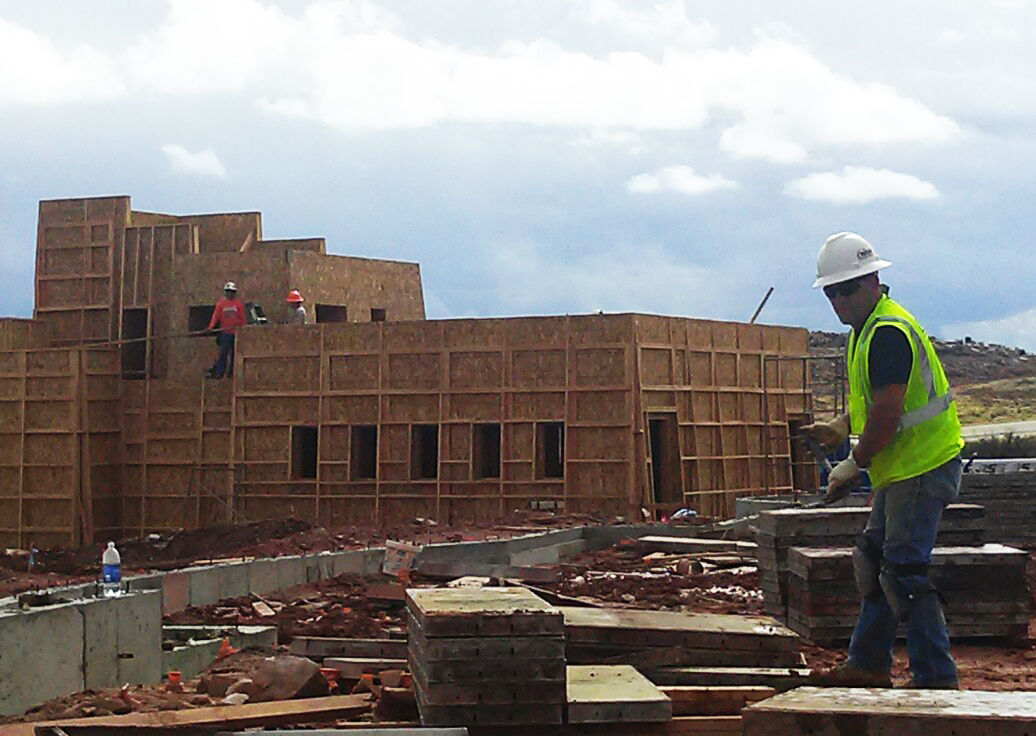Some information may be outdated.
The walls are going up for Moab Giants, an open-air dinosaur park and museum located at the junction of U.S. Highway 191 and state Route 313, about nine miles north of Moab.
The 44-acre park will include outdoor walking paths with life-size dinosaur replicas, a museum, two theaters, a cafe and a storage facility for artifacts.
Dr. Martin Lockney, a University of Colorado paleontologist and scientific adviser to the project, said that the focus of Moab Giants is largely scientific, and that it is not a “theme park.”
Lockney is also the founder and director of the Dinosaur Trackers Research Group. He has documented the extensive dinosaur trackways from the Jurassic time period found in the Morrison Formation on the western border of Arches National Park.
“We’re hoping to have quite a large presence in Moab,” Lockney said. “This facility is dedicated to science, community development and public education.”
Lockney said one of the key elements of the park will be showcasing dinosaur tracks, both cast, and actual.
“We want to focus on the Moab area and Western U.S., but we will have tracks from all over the world,” he said.
Park visitors will be able to walk through outdoor exhibits and view cast dinosaur tracks next to life-size dinosaur replicas. Inside the museum, actual dinosaur tracks will be on display. Presentations will be shown in the two theaters, and they will change as new discoveries are made.
The facility is also going to be used as a base for researchers in the area.
Moab Giants is the dream of Polish paleontologist Gerard Gierlinski, and is part of the Paleo-Safari project, an organization that is dedicated to the study and preservation of dinosaur tracks throughout the world. Paleo-Safari has constructed several similar parks around the world.
The project also has the support of the Polish Geological Institute, several international paleontological organizations and the University of Colorado.
“We’ve partnered with a lot of institutions,” Lockney said.
The park has been in the planning stages since 2009, when the Grand County Council approved a zone change for the area from Range and Grazing (RG) to Resort Special (RS) in preparation for the park developer’s application.
Grand County Community Development Director Kristine Braun said the standards in the RS zone district are intended for guest-oriented land uses in a rural setting.
“The standards include for such things as building design, site design, signage and dark-sky compliant lighting,” Braun said.
Jeff Pillus, a consultant to the project from SET Engineering, said that the developers have worked closely with the county to make sure that the facility is appropriate for the location, and that many precautions have been taken to minimize visual impacts to the landscape.
“Buildings are architecturally designed to fit the surroundings,” he said. “And parking is sunken so it won’t dominate the landscape.”
Pillus also said the full-scale dinosaur replicas will be “inconspicuous and tastefully displayed.”
Braun said that in 2012, the project received a Conditional Use Permit, and as part of this approval, the developers agreed to complete additional screening, if necessary, for the outdoor exhibits. She said that other screening elements already agreed upon with the planning commission included minimizing the parking area and providing additional landscaping.
Pillus said that construction is moving along on schedule and that it should be completed by spring of 2015, but that there would still be considerable work to do in setting up the exhibits. He also said that local contractors were being used in construction.
Lockney said that Moab is a premier location for this type of facility because of the abundance of dinosaur tracks in the area.
Both he and Gierlinski were in Moab last year excavating a track site near the Mill Canyon interpretive dinosaur bone trail.
“We’ve done all the research on that site,” Lockney said.
Lockney said he had known about the site for about five years, and that he had been involved in preliminary studies of the tracks since that time. In 2013, he received a permit from the BLM to excavate the site.
Tracks from several species were discovered in an area about the size of a football field, BLM paleontologist ReBecca Hunt-Foster said.
The tracks were found in the Ruby Ranch Member of the Cedar Mountain Formation, a maroon mudstone that formed in a mud plain during the Cretaceous period between 145-160 million years ago.
“It’s one of the only trackways in America that is this particular age,” Hunt-Foster said.
Though the BLM plans to leave the tracks in place, Lockney hopes to have casts made for display at Moab Giants. He also plans to use the facility as a base for studies and interpretation of the Mill Canyon track site.
“We really want to represent tracks from the Moab area,” Lockney said.
“Moab Giants” will include life-size dinosaur replicas and serve as a base for scientific research
“We’re hoping to have quite a large presence in Moab. This facility is dedicated to science, community development and public education.”
Appreciate the coverage? Help keep local news alive.
Chip in to support the Moab Sun News.





